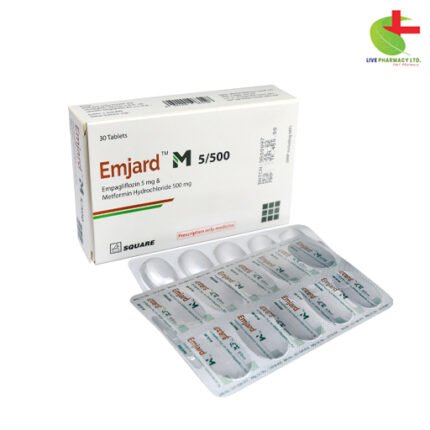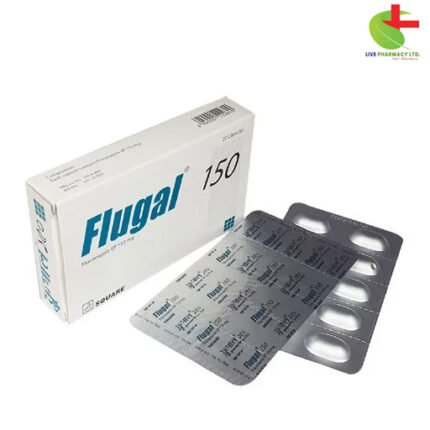Emjard M 12.5/500
120.00৳ Strip
- Empagliflozin-Metformin: A potent combination for type 2 diabetes management.
- Controls blood sugar levels alongside diet and exercise regimen.
- Empagliflozin reduces glucose reabsorption by the kidneys.
- Metformin lowers glucose production and enhances insulin sensitivity.
- Ideal for patients not adequately controlled with Metformin alone or in combination therapy.
 Brand
Brand
|
Square Pharmaceuticals PLC |
|---|---|
 Generics
Generics
|
Empagliflozin + Metformin Hydrochloride |
Indications
This medication is prescribed for adults diagnosed with type 2 diabetes mellitus, to be used alongside dietary adjustments and physical activity. It’s recommended in the following cases:
- When patients aren’t adequately managing their condition with the maximum tolerated dose of Metformin alone.
- In combination with other diabetes medications for those whose condition isn’t effectively controlled with Metformin and other medications.
- For patients already undergoing treatment with separate tablets of Empagliflozin and Metformin.
Pharmacology
Empagliflozin functions as an inhibitor of Sodium-Glucose Co-Transporter 2 (SGLT2), which plays a key role in reabsorbing glucose from the kidneys into the bloodstream. By inhibiting SGLT2, Empagliflozin reduces the reabsorption of glucose by the kidneys, lowering the renal threshold for glucose and increasing urinary glucose excretion.
Metformin Hydrochloride, on the other hand, belongs to the biguanide class of oral antihyperglycemic drugs. It effectively reduces both basal and postprandial plasma glucose levels without inducing hypoglycemia. Metformin Hydrochloride works by decreasing hepatic glucose production, reducing intestinal absorption of glucose, and enhancing insulin sensitivity, thereby increasing peripheral glucose uptake and utilization.
Dosage & Administration
Dosage should be tailored to each individual based on their response to treatment and tolerance levels. It’s recommended to take this combination medication twice daily with meals. To minimize gastrointestinal side effects associated with Metformin Hydrochloride, dosage escalation should be gradual. The maximum daily recommended doses are 2000 mg for Metformin Hydrochloride and 25 mg for Empagliflozin.
Recommended Starting Dose:
- For patients already using Metformin Hydrochloride, transitioning to this combination with Empagliflozin at 5 mg, maintaining a similar total daily Metformin Hydrochloride dose.
- For patients already using Empagliflozin, transitioning to this combination with Metformin Hydrochloride at 500 mg, maintaining a similar total daily Empagliflozin dose.
- For patients already on separate treatments of Empagliflozin and Metformin Hydrochloride, transitioning to this combination with equivalent total daily doses of each component.
- Patients with volume depletion who have not previously received Empagliflozin should correct this condition before starting this combination therapy.
Extended-Release Formulations:
Starting doses should be personalized based on the patient’s current medication regimen. Film-coated tablets should be taken twice daily with meals, while extended-release formulations should be taken once daily with a meal, with gradual dose escalation to minimize gastrointestinal adverse effects associated with Metformin. Dosage adjustments should be made based on effectiveness and tolerability, ensuring the maximum recommended daily doses of 2000 mg for Metformin Hydrochloride and 25 mg for Empagliflozin are not exceeded.
Renal Impairment:
Renal function should be assessed before initiating this combination therapy. It’s contraindicated in patients with an estimated glomerular filtration rate (eGFR) below 45 mL/min/1.73 m2.
Pediatric Use:
Safety and effectiveness in pediatric patients under 18 years of age have not been established.
Interactions
This medication may interact with various other drugs, including diuretics, insulin or insulin secretagogues, and those affecting glycemic control. Close monitoring and appropriate adjustments are recommended when co-administering with these medications.
Contraindications
This medication should not be used in individuals with hypersensitivity to Empagliflozin and Metformin, acute metabolic acidosis, severe renal failure, acute conditions affecting renal function, diseases causing tissue hypoxia, hepatic impairment, acute alcohol intoxication, or alcoholism.
Side Effects
Common side effects associated with Empagliflozin include urinary tract infections and genital mycotic infections, while those associated with Metformin include gastrointestinal symptoms. Other important adverse reactions may also occur, and patients should be closely monitored.
Pregnancy & Lactation
This medication is not recommended during pregnancy, especially during the second and third trimesters, and should be avoided while breastfeeding.
Precautions & Warnings
Several precautions and warnings should be considered before initiating this medication, including the risk of lactic acidosis, hypotension, ketoacidosis, acute kidney injury, urinary tract infections, hypoglycemia, vitamin B12 deficiency, and increased LDL-C levels.
Overdose Effects
In the event of an overdose, appropriate measures should be taken based on the patient’s clinical status. While single doses of up to 800 mg of Empagliflozin and multiple daily doses of up to 100 mg have not shown toxicity in clinical studies, lactic acidosis can occur with Metformin overdose.
Therapeutic Class
This medication belongs to the class of combination oral hypoglycemic preparations.
Storage Conditions
Store below 30°C, protected from light and moisture, and keep out of reach of children.













Reviews
There are no reviews yet.